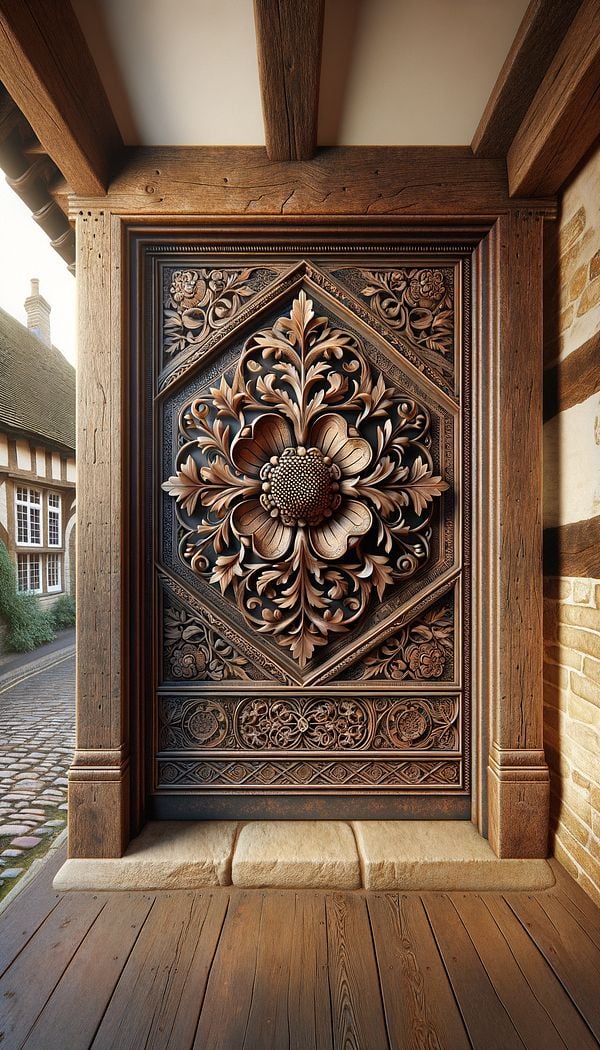What is a Tudor Rose?
A traditional floral symbol of England, often used in architecture and design.
Description
The Tudor Rose, also known as the Union Rose or simply the English Rose, is a heraldic emblem with a rich history and deep symbolic meaning. It is most widely recognized as the floral emblem of England, representing the union of two rivaling houses – the House of York and the House of Lancaster – following the Wars of the Roses in the late 15th century. The emblem combines the white rose of York and the red rose of Lancaster, symbolizing peace and unity.
In interior design and architecture, the Tudor Rose is a beloved motif, reflecting a blend of historical significance and ornamental beauty. This emblem can be found in many forms, including carved wood details, stained glass windows, fabrics, and more. Its inclusion in design elements often brings a touch of regal elegance and historical depth to a space, making it a popular choice in traditional and historical periods and movements-inspired interiors.
In addition to its symbolic and historical value, the Tudor Rose is appreciated for its versatile design possibilities. It can be seamlessly incorporated into various decorative objects, furniture types, and textiles and upholstery, offering designers and homeowners alike the opportunity to engage with England’s rich cultural heritage while adding a classic decorative element to their projects.
Usage
The Tudor Rose is often used as a decorative motif in traditional English interiors and can be found on everything from furniture types and wall treatments and finishes, to textiles and even architectural details like mantelpieces and door frames. It brings a sense of history and nobility to both residential and public spaces, such as historic hotels, traditional pubs, and heritage sites.
FAQs
-
Is the Tudor Rose exclusive to England?
While the Tudor Rose is an emblem of England and deeply rooted in its history, its use in design can be found globally, especially in places influenced by British culture or in projects that aim to evoke a traditional English aesthetic.
-
Can the Tudor Rose be used in modern interior design?
Yes, the Tudor Rose can be integrated into modern design schemes. Its historical significance and decorative appeal make it a versatile motif that can add depth and character to contemporary spaces when used thoughtfully and sparingly.
-
Are there any copyright restrictions on using the Tudor Rose in designs?
As a historical emblem, the Tudor Rose is generally considered to be in the public domain and free to use. However, specific designs or interpretations of the rose might be copyrighted, so it's important to check the specifics when using pre-made designs or artwork.
Practical Application
When incorporating the Tudor Rose into your design, consider its historical context and symbolism to ensure it complements the overall theme of your space. Use it as a focal point in rooms with a traditional or historical theme, or blend it subtly into modern interiors for a touch of elegance and history. Experiment with different materials and scales to find the perfect application for your project.
-
Architectural Elements199 articles
-
Design Styles478 articles
-
Furniture Types599 articles
-
Textiles & Upholstery252 articles
-
Wall Treatments & Finishes157 articles
-
EbonizeA method of darkening wood to mimic the appearance of ebony.
-
Accent WallAn accent wall is a wall that is designed to stand out from the surrounding walls in a room.
-
Egg & DartEgg & Dart is an ornamental design featuring alternating egg-shaped and dart or arrow-like elements.
-
Lincoln RockerA Lincoln Rocker is a specific style of rocking chair.
-
Coil CountCoil count refers to the number of coils used in the construction of a mattress.
